Johanniskirche (Wuppertal)
The St. John's Church in Wuppertal district Heckinghausen was a native of the 1872 church . It was the third house of God built for the Lutheran congregation of Barmens .
history
In the course of industrialization, the number of Lutherans in Barmen increased sharply, not least due to the influx from largely Lutheran Prussia . The old church in Wupperfeld was the only Lutheran church in Barmen to date and became too small for the Lutheran community of Wupperfeld, which had grown to around 10,000 by 1850. In 1851 the congregation began to think about new church buildings, in 1866 plans to build a large church were abandoned and a decision was made in favor of two new, smaller churches in two different peripheral areas of the congregation: the Friedenskirche in the west, near the Reformed Gemarker Church , and the Johanniskirche in the east the opposite side of the Wuppers . The Berlin architect Hermann Cuno was commissioned to plan both churches . The Johanniskirche was the smaller and later started church, the foundation stone was laid in 1869, on September 19, 1872, almost a year after the opening of the Friedenskirche, the Johanniskirche was consecrated.
The church was destroyed on the night of the great bombing raid on Barmen on May 30, 1943. The ruin stood until 1953, but was then demolished due to the planning of a street (never carried out).
architecture
The Johanniskirche was a neo - Gothic three-nave hall church without a transept and offered space for 900 worshipers. Six large axes of tall double windows on the sides and four equally tall ones in the northern entrance facade illuminated the church space. The central square tower, which was crowned with a pointed octagonal roof, was not in front of the church building, as is usual in the Protestant churches in Wuppertal, but integrated into the facade, entrances on the long sides led into two stairwells behind the main facade. On the stepped gables of the two long sides, nine delicate branch towers repeated the main tower. An annex, which is architecturally connected to the church, housed the rectory with a sexton's apartment and a confirmation hall.
The interior was a wood-covered hall with two galleries on the long sides and one above the entrance, which originally supported the organ . The room was closed off by a vaulted five-eighth choir in the south.
Furnishing
After World War II, the 1876 by the organ workshop in Meier was Herford built organ placed in the choir, originally on the side of Triumph arc mounted pulpit was dismantled and a central axis from Altar created pulpit and organ. A short time later Albert Schweitzer gave a concert on this organ in 1928.
Paul Gerhardt House
On the site of the destroyed church, a community center with a church service hall was opened in 1957, which was named Paul-Gerhardt-Haus in 1959. In addition to the church hall in Ackerstraße, this was one of the two worship rooms of the Evangelical congregation in Heckinghausen, united in the 1980s, today it is only used as a meeting room and congregation hall and for special services. The church hall in Ackerstraße has since served as a place of worship for the Protestant community of Wuppertal-Heckinghausen. Since 2012 the Paul-Gerhardt-Haus has been used as a "winter church" in order to save the expensive heating of the church hall in winter. This year (2016) the PGH will be completely renovated and from 2017 it will be used all year round for church services and all community events.
literature
- Werner Franzen: Worship sites in transition. Evangelical church building in the Rhineland 1860–1914 (= writings of the archives of the Evangelical Church in the Rhineland. No. 34). 2 volumes. Archive of the Evangelical Church in the Rhineland, Düsseldorf 2004, ISBN 3-930250-47-0 (At the same time: Duisburg, University, dissertation, 2002, online ).
- Sigrid Lekebusch, Florian Speer (eds.): Churches and places of worship in Barmen (= churches and places of worship in Wuppertal. Vol. 2 = Contributions to the history and local history of the Wuppertal. Vol. 43). Schmidt, Neustadt (Aisch) 2008, ISBN 978-3-87707-721-4 .
Web links
Individual evidence
- ^ History of the parish Heidt ( Memento from September 15, 2008 in the Internet Archive ) on their website
- ↑ Portrait of the organ on the organist Detlev Bahr's homepage
Coordinates: 51 ° 16 ′ 13.4 ″ N , 7 ° 13 ′ 30.2 ″ E



